Garden a shambles in August? I don't think so!!
Tuesday, August 30, 2011
There is, or at least there has been until faily recently, a
conception that gardens in August are rather dull and subdued, as
if taking a rest before the pyrotechnics of autumn. The initial
summer flush of flowers has faded, in a dry summer the drought will
have taken its toll on the vigour of plants and many gardeners take
a break in August (the landed gentry take flight for their
country estates - I do hope some of them are regular visitors
to our website!) All this can leave the garden looking shabby and
uncared for. However if as in this year, there is plenty of rain,
the weeding and dead heading are regularly attended to and the
right choice of plants is made, the August garden, can rival any in
the year.
The walk to the nursery featuring on the left impatiens
tinctoria at 8 feet, and on the right perennial rudbeckia lacinata
at only 7 feet with in the foreground rudbeckia "Goldsturm" the
best late flowering plant in the garden: beautiful and
bombproof
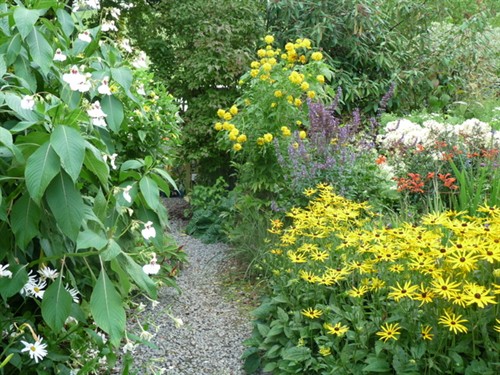
The Paddock Garden borders still looking good in late August
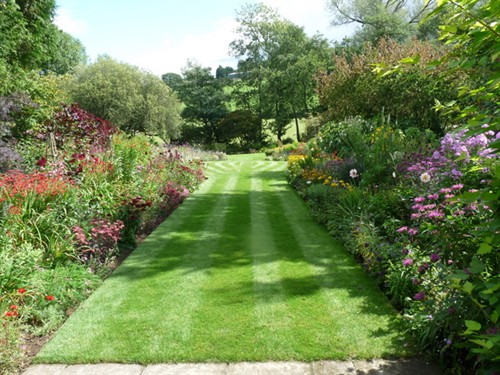
Plant selection is so important in ensuring a continuity of
colour from May to September and possibly beyond depending on when
the first frost comes along. Modern planting styles such as prairie
planting. the use of grasses, and the resurgence of plants like
dahlias has revolutionised how we now view August in the garden.
The use of tender plants bedded out for the summer and improved
strains of longer lived annuals has all added to the gardeners
ability to make August a special month, as unique in its own way as
the first full flush of June. In addition the vegetable garden is
at its most productive with the widest choice of vegetables for the
table. More on all of this later.
Weather
Dull, cool and wet sums up the month. It wasn't wet all the time
but just enough to persuade some stalwarts like phlox to give up
rather sooner than normal, but the weather was very welcome for all
the vegetables save the more tender forms like courgettes, tomatoes
and peppers. Some nights were very cold with as low as 4C recorded
on 2 nights and many others in single figures. The maximum
temperature recorded was just 21C. At least the lawns look
wonderfully green and a second cut of silage is a welcome bonus to
many of our farmer neighbours.
Garden update
The border makeovers we did in the spring have paid dividends.
Some of this was forced on us by the losses of last winter and some
by a critical appraisal of the impact and balance of some of the
more established borders. We have also this year continued to
refresh borders with plants from the nursery (or the rather too
regular plant buying trips) right through the summer months so that
there will still be plenty for our late summer visitors to enjoy.
The rains and regular feeding with Vitax Q4 or fish.blood and bone
fertilsers have made a tremendous contribution to plant vigour,
especially roses and later flowering clematis. Regular deadheading
makes a significant contribution too and although this is a daily,
time consumimg task (thank goodness for retirement!!) it does pay
dividends with many plants repeat flowering which also greatly
extends the season.
The vegetable harvest has been incredible with most doing
exceptionally well and promising crops of runner beans, sweetcorn,
courgettes and brassicas beginning to overwhelm us. We succession
plant all of these to ensure a long cropping season and to avoid
gluts. Runner beans in particular are cropped from 3 sowings; one
under heat in early April, one under heat in early May and one
direct sown in the ground in early June. This usually ensures a
long harvest period of top quality beans from mid July until the
frosts with not a stringy bean in sight.
We harvested an amazing crop of potatoes - a quarter of a ton!!
from under 100 square metres. As always Desiree was the best
cropper but we have had some large bakers from Picasso and Maris
Piper. How on earth we are going to eat them all I don't know but
our neighbours and friends will probably come to the rescue.
Without doubt the best vegetable year since 2005. Currently we can
harvest from fresh 20 varieties of vegetables, sublime Autumn Bliss
raspberries and the first of the Bramley apples. 5 a day? -
easy!!
A river of potatoes - some of the Desiree crop drying in the
sunshine (I chose the right day to dig them!)
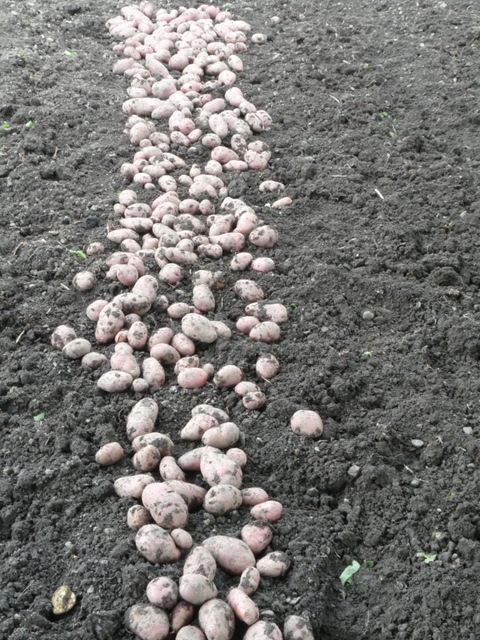
What's looking good?
Most of the borders still have a dramatic colourful impact and
it is quite difficult to single out particular stars. This time
last year it was the crocosmias that caused me to wax lyrical and
they look equally marvellous this year too but to ring the changes
here are some that may not be used to the limelight. What a great
lead in that is and not planned. The paniculata hydrangeas sailed
through the winter and because they flower on new wood they are
immune to severe winters. For this reason, and as we are in such a
frost pocket, we grow plenty and there is a wide selection to
choose from. Currently in bloom we have paniculata "Unique",
"Phantom", Early Sensation", "Brussels Lace", Vanille Fraise",
"Grandiflora", "Kyishu", and this is where we came in, "Limelight".
Lime green in its early stages, turning to creamy white, I have
brilliantly (modest as always!!) teamed this with persicaria
"Red Dragon" which is weaving its way through the hydrangea in the
most sinuous - OK SEXY - way! I love it and so did one of our
visitors yesterday which is why I don't feel I have to hold back on
the praise for such incredibly gifted planting!! (I am going to
keep you waiting for a pic of this sublime combination and hope my
camera is up to it)
Hydrangea paniculata "Unique" the first of this group I
ever purchased and still one of the best. Like many in this group
the flower colour changes from white to pink as it ages
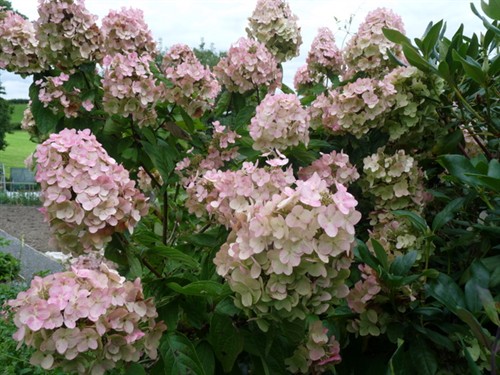
The later flowering clematis are having a tremendous year with
well over 30 forms currently in flower all over the Gardens. Many
are climbers growing in a natural way through shrubs or small trees
but a few are herbaceous forms now forming impressive clumps from a
shrubby framework. Apart from thousands of cultivated hybrids there
are about 300 wild species forms to be found throught the world.
They are classified by botanists into Sections and a particular
favourite of mine is the Viorna Section found in the USA. This
Section can be partularly challenging to grow in a garden setting
but one form , the texensis from the southern states including
Texas, has been regularly hybridised over the last hundred years.
Commonly called the tulip flowered clematis it is the only red
flowered clematis to be found in the wild and has given its
colouring to all the red clematis currently in cultivation. The
flowers of some of these closely resemble the wild form in that
they are tulip shaped but larger than the species form which is
tiny. Currently we have named forms of "Duchess of Albany",
"Gravetye Beauty", "Princess Diana" and just coming into flower
"Ladybird Johnston". They are given a dedicated area in the shrub
rose border where their pruning regime coincides with the roses and
size (6 - 8 feet maximum) makes for comfortable bedfellows for the
larger shrub roses. Like many clematis they take a while to get
established, but when they do are striking, unusual and
beautiful.
"Duchess of Albany"
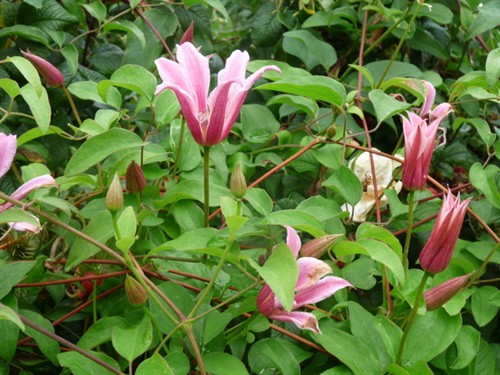
"Gravetye Beauty"

Other later flowering clems.
Heraclifolia a semi-shrubby herbaceous clem. with scented
flowers. This is the species form but there are some choice named
cultivars one of the best being "Wyevale"
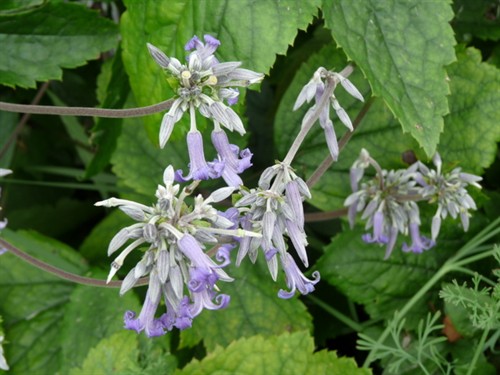
A superb late large flowered which is sometimes attributed to
the viticella section, "John Huxtable" is a really good white with
large flowers for a late flowering form
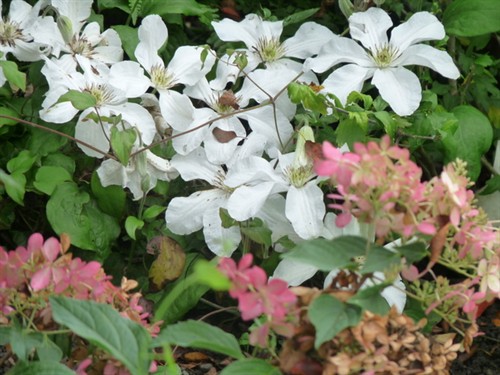
Here is a true viticella: "Kermesina" a good, reliable vigorous
reddish purple. Like all viticellas cut back to 2 buds in early
spring it will make good growth to 8 feet and flower by July and it
is mildew and wilt free! What more could you ask?

The longest flowering section from May to October is the
tanguticas, the so called orange peel clematis. This one is
"Lambton Park" and like all tanguticas it has wonderful seed heads
and flowers at the same time. And it is easy from seed and it
sometimes flowers in its first year from seed! A real hero
especially as some clems can take up to 5 years from seed to
flower.
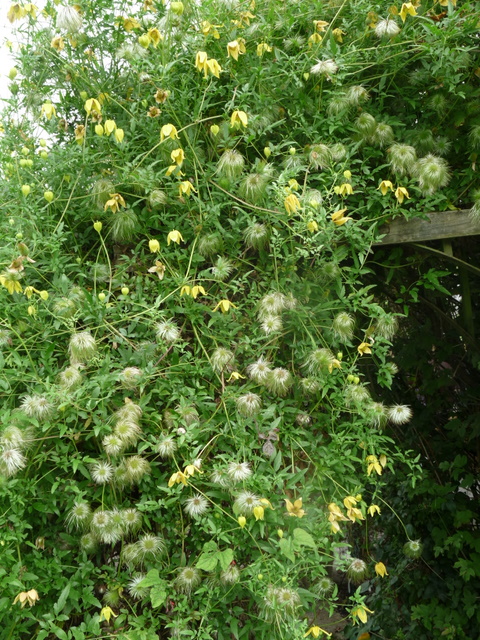
And finally one of the oldest in cultivation from 16th Century,
clematis viticella Flora Plena Elegans or commonly ladies bower, a
first rate double form of viticella with long lasting flowers.

Hardy annuals tend to be largely underrated and although we
offer plenty for sale they are not our best sellers. If I hear "but
it's only an annual" again I will go nuts!! Poppies,cornflowers,
nicotianas in a wide variety, sunflowers, nigellas, molleculla
("Bells of Ireland"), iberis, amaranthus, eschsholzias,
convolvulus, cosmos, rudbeckias, cleomes are staples of our borders
and we would not want to be without them. Some poppies are short
lived admittedly but are still worth their place. The Ladybird
poppy is the only annual that consistently sells out. But if you
want annuals that look like perennials, grow tall and flower from
midsummer until the frosts and sometimes into a second year look no
further than rudbeckias and cosmos. They both come in a good range
of colours and give structure and loads of colour until late autumn
frost permitting. They are classified as half hardy annuals so need
to be started off in protected conditions, don't need a lot of heat
to germinate, and can be sown quite late in the case of cosmos but
rudbeckias need to be started earlier in order to flower in August.
They are however reputed to be capable of overwintering and
flowering again a second year; cheaper too for a packet of seed
than a tray of bedding plants.
Rudbeckia "Marmalade" in the orange and blue border. If you had
told me a few years ago I would have had an orange border I would
never have believed you!
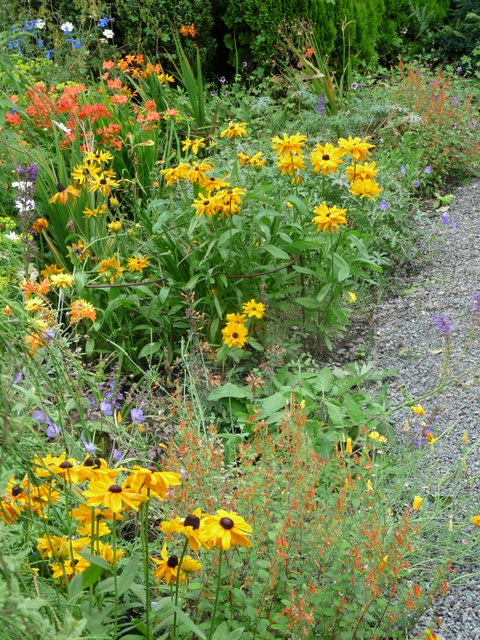
And the first ever red rudbeckia "Cherry Brandy" a stalwart of
the Red Border taking over when the "Ladybird" poppies finish.
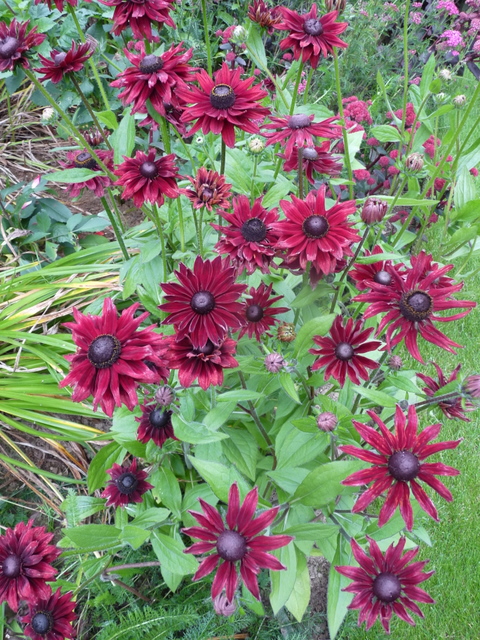
Wildlife and countryside
A quiet month with no major news stories. It is however sad to
note how few dragonflies there are this year. Whether this is
reflection on last winter or a comment upon the dull summer I don't
know. What is clear however from clearing out the Paddock Pond is
an absence of dragonfly larvae, a worry for the future too as some
can take a couple of years to become dragonflies.
It's a similar story with butterflies - even cabbage whites are
scarce this year which as a vegetable grower is good news. I have
seen just a few red admirals and tortoiseshells but no commas or
painted ladies which are usually both common at this time of
year.
Kingfishers are often heard but rarely seen usually along the
river bank at the bottom of the garden. Occasionally they stray
from the river over the adjacent fields and garden and it is
strange to see them in what is an alien setting.
The trees are already turning colour and for the first time the
horse chestnuts have been affected by the horse chestnut leaf miner
which burrows into leaves causing them to go brown and fall long
before the autumn comes. It has been a growing problem in England
for some years and now appears to have arrived in our part of
Wales. It doesn't kill the tree but weakens them and usually means
few if any conkers - a big part of autumn in my country
childhood.
The rams are back in the adjacent fields doing what comes
naturally. 4 Texel rams to about 200 ewes - no wonder they look
tired but happy. Texels are real characters, short and squat with
thick necks and a swagger. A bit like the best Welsh front row
forwards!
Visits
Only one group visit this month from Bronwydd Garden Club on one
of the few good days of the month. We also had several individual
visitors from as far apart as Devon and Essex.
Our main visitor event occurred last Saturday when a local
couple Matthew and Nia Page had their wedding photographs taken in
the garden - a first for us and a very enjoyable experience. Their
generous donation to the NGS is very much appreciated They and
their close family and friends were here for 2 hours but were well
fortified with champagne. Everyone was well pleased with the venue
and the the many photo opportunities it presented. The photographer
made very good use of the Paddock Pond to take reflected images and
the bridegroom was lucky at one stage not to be thrown in by his
best man and ushers! At this point the best man split the trousers
of his morning suit which presented another photographic
opportunity, one it may be difficult to explain when the photos are
published! As we always try to do everything we can for our
vistors. Moira stitched up the trousers and no he wasn't still
wearing them at the time.
Pics of Matthew and Nia's wedding



Back to more mundane matters, we have 3 more pre booked group
visits next week by the end of which we will have had in excess of
1,000 visitors and hope to have grossed nearly £5,000 for the NGS.
We are over the moon with this which is by far our best ever
year.
The following week the Autumn and Winter series of garden
talks begins with 12 already booked. If you are looking for a
speaker for your club or event, see our current list of talks
elsewhere on our website and please get in touch to discuss your
requirements.